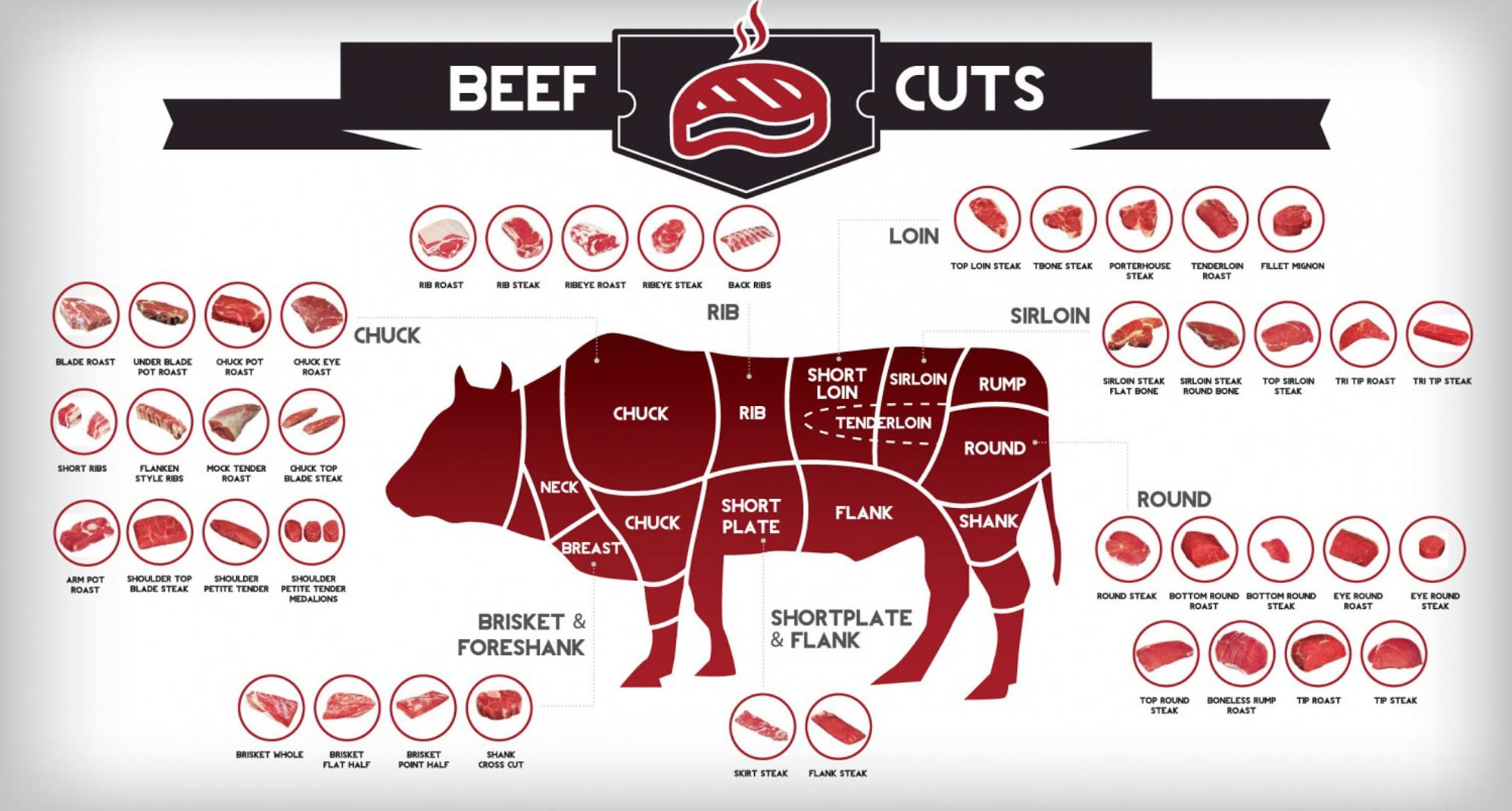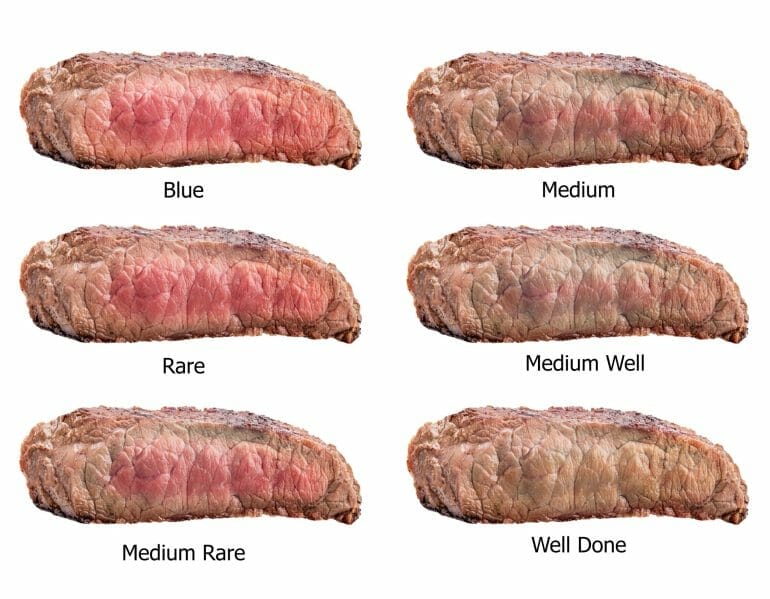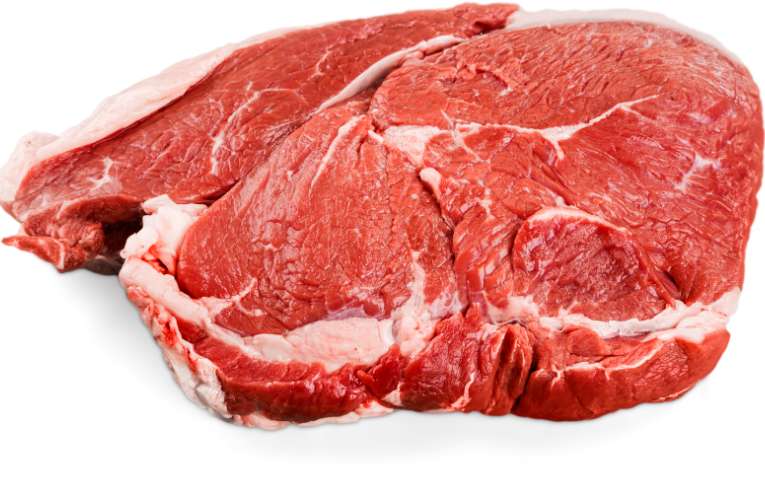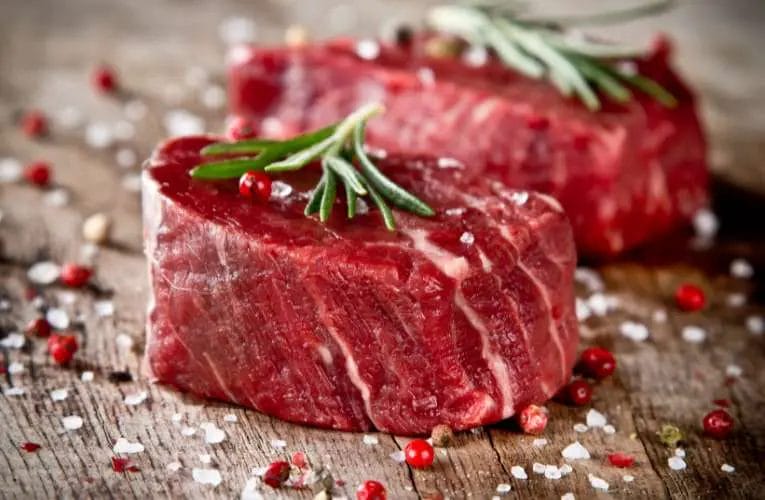If you’re a carnivore at heart, you’ve probably wondered what steak is made of. Steak is a juicy and flavorful cut of meat that is primarily derived from beef. It is typically sourced from well-marbled parts of the animal, such as the rib, loin, or sirloin.
This exquisite delicacy is known for its tenderness and rich taste, making it a favorite choice for meat lovers around the world.

Understanding the Best Beef for Steak: Prime vs. Choice
In this section, we will delve into the differences between two popular grades of beef, Prime and Choice, to help you make an informed decision when choosing the best beef for your steaks.
When it comes to beef, the grading system established by the United States Department of Agriculture (USDA) plays a significant role in determining the quality and tenderness of the meat. The two most commonly recognized grades are Prime and Choice.
Prime Beef
Prime beef is the highest grade of beef available and is known for its exceptional flavor, tenderness, and marbling. It is typically sourced from young, well-fed cattle, and has generous intramuscular fat, which gives it that melt-in-your-mouth quality.
Prime beef is often found in high-end steak restaurants and is favored by steak connoisseurs for its superior taste.
The marbling in Prime beef refers to the thin veins of fat that are interspersed throughout the muscle tissue. This marbling is what gives the meat its rich flavor and juiciness, as the fat melts during cooking and infuses the meat with moisture and flavor. The more marbling present, the higher the grade of beef.
However, it’s important to note that Prime beef is relatively rare, accounting for only about 2% of all beef produced in the United States. Due to its limited availability and higher demand, Prime beef tends to be more expensive than other grades.
Choice Beef
Choice beef is the next grade below Prime and is also highly regarded for its quality. It is more widely available and more affordable than Prime beef, making it a popular choice for those looking for a balance between cost and taste.
Choice beef still exhibits good marbling, although not as plentiful as in Prime beef. The meat is generally flavorful, tender, and well-suited for grilling or broiling. While it may not have the same level of marbling as Prime beef, it still delivers a delicious steak that satisfies the palate.
Key Differences
Now that we have a basic understanding of both Prime and Choice beef, let’s highlight the key differences between the two:
- Quality: Prime beef is considered the highest quality available, while Choice beef is a close second.
- Flavor and Tenderness: Prime beef offers exceptional tenderness and flavor due to its generous marbling, while Choice beef is still flavorful and tender but with slightly less marbling.
- Availability: Prime beef is relatively rare and accounts for a small percentage of beef produced, whereas Choice beef is more widely available.
- Price: Prime beef is typically more expensive than Choice beef due to its limited availability and higher demand.
Ultimately, the choice between Prime and Choice beef comes down to personal preference and budget. If you’re looking for the absolute best in terms of flavor and tenderness and don’t mind paying a premium, Prime beef is the way to go.
On the other hand, if you’re seeking a high-quality steak at a more affordable price point, Choice beef is an excellent option.
Understanding the differences between Prime and Choice beef allows you to make an informed decision when selecting the best beef for your steaks.
Whether you opt for the exceptional quality of Prime beef or the more accessible Choice beef, both options are sure to satisfy your taste buds with a delicious and juicy steak.

The Science of Grilling Steak: Achieving the Perfect Cook
Grilling a steak to perfection is an art that many aspire to master. The tantalizing aroma of a sizzling steak on the grill can make mouths water and set the stage for a memorable dining experience.
However, achieving that perfect cook requires more than just guesswork and intuition. It involves understanding the science behind grilling and using that knowledge to elevate your steak game.
The Maillard Reaction: Unlocking Flavor
One of the key factors in achieving a deliciously cooked steak is the Maillard reaction. This chemical reaction occurs when amino acids and reducing sugars in meat are exposed to high heat, resulting in browning and the development of complex flavor compounds.
The Maillard reaction is responsible for the irresistible crust that forms on the surface of a perfectly grilled steak.
To maximize the Maillard reaction, it’s important to start with a dry steak. Patting the steak dry with paper towels before grilling helps remove excess moisture, allowing for better browning.
Additionally, preheating the grill to a high temperature ensures that the steak is exposed to intense heat, promoting the Maillard reaction.
The Ideal Temperature: Medium-Rare Magic
Another crucial aspect of grilling steak is achieving the ideal internal temperature. Many steak aficionados swear by the medium-rare doneness level, as it allows the steak to retain its juiciness and tenderness while still being cooked to a safe temperature.
The recommended internal temperature for a medium-rare steak is around 130-135°F (54-57°C). Using a meat thermometer can help you accurately gauge the doneness of your steak and avoid overcooking.
Remember that the steak will continue to cook as it rests, so it’s essential to remove it from the grill a few degrees below your desired temperature and let it rest for a few minutes before slicing.
The Role of Marbling: Flavor and Moisture Balance
When selecting a steak for grilling, pay attention to its marbling. Marbling refers to the intramuscular fat within the meat, which adds flavor and helps keep the steak moist during cooking. Steaks with well-distributed marbling are generally more tender and flavorful.
Popular cuts with excellent marbling include ribeye, New York strip, and prime rib. These cuts are known for their rich flavor and succulence when grilled to perfection. However, even leaner cuts can benefit from techniques such as marinating or dry brining to enhance their tenderness and flavor.
The Resting Period: Allowing Juices to Settle
After removing the steak from the grill, it’s tempting to dive right in. However, allowing the steak to rest is crucial for optimal flavor and juiciness. During the resting period, the meat’s juices redistribute, resulting in a more evenly flavored and tender steak.
As a general rule, let your steak rest for about 5-10 minutes under a loose foil tent to retain heat. This resting time allows the internal temperature to stabilize, ensuring that the juices stay locked within the meat when it’s finally cut and served.
Experimentation and Personal Preference
While the science behind grilling steak provides a solid foundation, it’s essential to embrace experimentation and cater to personal preferences. Grilling is a subjective art, and individual tastes can vary widely.
Don’t be afraid to try different cuts of steak, marinades, or seasoning blends to discover your unique flavor profile. The more you experiment, the closer you’ll get to mastering the perfect cook that satisfies your taste buds and leaves you craving more.

Exploring Alternative Steak Options: Beyond Beef
Steak is a beloved dish that many people enjoy. Its juicy and tender texture, combined with its rich flavor, makes it a popular choice for meat lovers.
However, for various reasons, some individuals may be looking for alternatives to traditional beef steak. One option that has gained considerable attention in recent years is Beyond Beef.
Beyond Beef is a plant-based alternative to beef that aims to replicate the taste and texture of traditional steak. It is made from a combination of plant-based ingredients, such as peas, mung beans, and rice, that are processed to create a meat-like texture.
This innovative product has been praised for its ability to provide a similar sensory experience to beef without the environmental impact associated with conventional meat production.
One of the main advantages of Beyond Beef is its environmental sustainability. Traditional beef production is known to have a significant carbon footprint and contributes to deforestation and water pollution.
In contrast, Beyond Beef production requires fewer resources and generates fewer greenhouse gas emissions. This makes it an appealing choice for individuals who are conscious about reducing their ecological impact.
Another benefit of Beyond Beef is its nutritional profile. While traditional beef is a good source of protein, it is also high in saturated fats and cholesterol.
Beyond Beef, on the other hand, is free from cholesterol and contains less saturated fat. It is also a good source of protein, making it a suitable option for individuals who follow a plant-based or vegetarian diet.
In terms of preparation and cooking, Beyond Beef is quite versatile. It can be cooked in a similar manner to traditional steak, such as grilling or pan-searing.
The plant-based protein retains moisture well, resulting in a juicy and flavorful final product. It can be seasoned and marinated just like beef, allowing for a wide range of flavor options.
When it comes to taste, Beyond Beef strives to replicate the umami flavor found in beef. While it may not be an exact replica, many individuals find it to be a satisfying alternative.
The texture of Beyond Beef is also comparable to that of traditional steak, providing a meaty bite that can please even the most discerning palates.
Furthermore, Beyond Beef offers a cruelty-free option for those concerned about animal welfare. Traditional beef production involves the raising and slaughtering of animals, which can be distressing to many people.
By choosing Beyond Beef, individuals can enjoy a steak-like experience without contributing to animal suffering.
It is worth noting that while Beyond Beef offers a promising alternative to traditional steak, personal preferences may vary. Some individuals may prefer the taste and texture of beef, while others may find Beyond Beef to be a suitable substitute.
Ultimately, the decision to explore alternative steak options comes down to personal choice and dietary preferences.

Enhancing the Flavor of Steak: Marinades and Seasonings
Steak is a beloved culinary delight that is enjoyed by meat lovers around the world. Its juicy and tender texture makes it a perfect choice for a hearty meal. However, sometimes a plain steak just doesn’t cut it. That’s where marinades and seasonings come into play.
By infusing your steak with various flavors, you can take it to a whole new level of deliciousness. In this section, we will explore the art of enhancing the flavor of steak through marinades and seasonings.
1. The Purpose of Marinades:
Marinades are a mixture of ingredients that are used to soak and flavor the steak before cooking. The primary purpose of a marinade is to add moisture, tenderness, and flavor to the meat. It can also help to tenderize tougher cuts of steak.
Marinades typically consist of a combination of acidic ingredients like vinegar or citrus juice, oil, herbs, spices, and aromatics. The acidic component helps to break down the muscle fibers, making the meat more tender, while the other ingredients add depth and complexity to the flavor profile.
2. Choosing the Right Marinade:
When it comes to choosing a marinade for your steak, the options are virtually endless. You can go for a classic combination like soy sauce, garlic, and Worcestershire sauce, or get creative with ingredients like balsamic vinegar, honey, or Dijon mustard.
The key is to choose flavors that complement the natural taste of the beef. For example, a citrus-based marinade works well with a lean cut of steak, whereas a red wine and herb marinade pairs perfectly with a rich and fatty cut.
It’s important to note that different cuts of steak require different marinating times. Thicker cuts like ribeye or T-bone may need to marinate for several hours or even overnight, while thinner cuts like flank steak can be marinated for just a couple of hours.
3. Tips for Marinating:
To achieve the best results with your marinade, here are some tips to keep in mind:
- Make sure the steak is fully submerged in the marinade to ensure even flavor distribution.
- Place the steak and marinade in a resealable plastic bag or a shallow dish covered with plastic wrap.
- Allow the steak to marinate in the refrigerator to prevent bacterial growth.
- Remove the steak from the marinade and let it come to room temperature before grilling or cooking.
- Discard any leftover marinade that has come into contact with raw meat to avoid cross-contamination.
4. The Art of Seasoning:
In addition to marinades, seasonings play a vital role in enhancing the flavor of steak. Seasonings are dry rubs or spice blends that are applied to the surface of the meat before cooking. They add an extra layer of flavor and can create a delicious crust on the steak.
Common seasonings for steak include salt, pepper, garlic powder, onion powder, paprika, and herbs like rosemary or thyme. The key to effective seasoning is to apply it generously and evenly on all sides of the steak.
Let the seasoned steak rest for a few minutes before cooking to allow the flavors to penetrate the meat.
5. Pairing Marinades and Seasonings:
The beauty of marinades and seasonings is that they can be used in combination to create a harmonious flavor profile. For example, you can marinate the steak in a tangy teriyaki marinade and then season it with a blend of sesame seeds, garlic powder, and black pepper.
The marinade will infuse the steak with sweetness and acidity, while the seasoning will add a delightful crunch and extra burst of flavor. Experimenting with different marinades and seasonings can lead to exciting and delicious results.

FAQs
What is steak made of?
Steak is made from beef, specifically the muscles of cows. It is a popular and flavorful cut of meat that is often grilled or pan-fried.
Conclusion
In conclusion, steak is a delicious and popular meat dish enjoyed by many around the world. It is made from high-quality cuts of beef, such as ribeye, sirloin, or tenderloin. The tender and flavorful nature of steak makes it a favorite choice for grilling, pan-searing, or broiling.
Whether you prefer your steak rare, medium-rare, or well-done, it provides a satisfying and hearty dining experience. From juicy T-bones to mouthwatering filets, steak offers a range of textures and flavors to suit various palates.
So, treat yourself to a juicy, perfectly cooked steak and indulge in its savory goodness.

